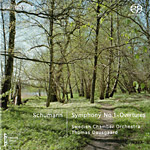Thomas Dausgaard has some interesting ideas about Schumann’s Symphony No. 1. He takes Schumann’s Allegro molto vivace marking to heart and drives the first movement at a stimulatingly brisk pace. He also makes the most of the score’s dynamic markings, resulting in some pretty explosive contrasts–especially when the timpani loudly strikes or rolls. However, his one bad idea–going for an “authentic” period-style sound–proves fatal. Yes, the increased ensemble clarity and rhythmic acuity is striking, but employing, or simulating the sound of gut strings seriously undercuts the music’s power. The orchestral timbre is overly bright, as if someone had turned the treble way up. This brightness only gets worse in tutti passages, where it becomes strident. The aforementioned strings sound perpetually undernourished, and in the scherzo they take on a wheezing quality (not unlike an accordion). Things don’t improve in the finale’s rapid passages: compare the Swedish Chamber Orchestra’s insipid sonority to the warm, smooth polish of the Gewandhaus Orchestra for Chailly, or the Staatskapelle Berlin for Bareboim (to name just two relatively recent examples).
The coupled overtures are more enjoyable, even if this stems in part from their relative unfamiliarity. Again, Dausgaard has some good ideas, which he puts to good use in the Genoveva and Bride of Messina overtures, as well as in Schumann’s early “Zwickau” Symphony movement. The Overture, Scherzo and Finale was previously recorded by Sawallisch (among others), and it’s hard to improve upon the performance of that accomplished Schumann conductor. Dausgaard, however, with his vibrant energy and pointed rhythms, does surprisingly well. (Interestingly, the strings have a little more body and presence here than in the symphony.) So if you are interested in just the “fillers”, you might find this disc a worthwhile acquisition since they comprise 60 percent of the program. Those wanting primarily the symphony should keep their distance.
































